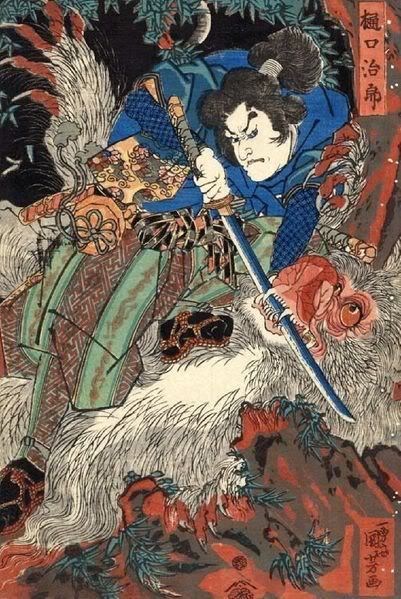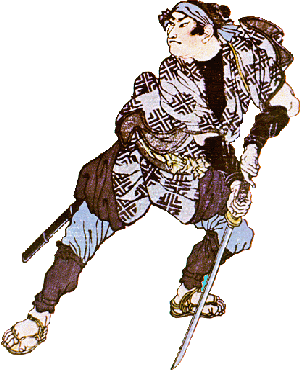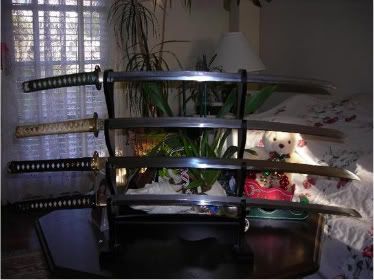The Art of Japanese Swordsmanship
by Jay Mijares

Part One - The Battle is Fought in the Mind
For those who haven't seen the Jet Li movie “Hero,” there's a brilliant swordfight between Li and Donny Yen. What makes it so unique is that half of the swordfight actually takes place in the minds of both opponents. They imagine the fight between them: each attack, each stroke, each parry, each anticipated counter move is seen in their minds. Isn't that the way we write? Our greatest action pieces have to be visualized in the mind first before they come to life on paper. But with something as specific as a swordfight, you have to know what you're doing before you write in detail about it.
When I submitted my first short story to SwordsEdge.net, it involved a swordfight between a samurai and a demon. As I wrote it, I could feel every single move made by my hero. I stood in the middle of my living room with my own katana in hand and I went over every move. I could feel the fatigue growing in his arms. I could feel the sword starting to get heavier and heavier. And every single swing and slice that he made, I could not only see it in my mind, but I could duplicate it in the real world.
One of the reasons that I could feel the fight in both mind and body is because I practice a form of Japanese Swordsmanship called Iai Batto Do. “Iai” and “Do” means “the way of the sword”. Iaido is the most common form of Japanese Swordsmanship, which emphasizes the drawing and returning of the sword to its scabbard. “Iai Batto Do” is a more combat-oriented art which emphasizes not just drawing the sword correctly, but using it effectively once it’s out of the scabbard.
Iaido in general—and there are many, many schools—can trace its lineage back almost 400 years. Some claim much longer, but that has never been fully verified. In a time when the firearm was becoming more prevalent, swordsmanship became less and less combat-effective, save for the schools and swordsmen who decided to preserve their techniques and pass them down their students and to their student's students.
Our curriculum encompasses three aspects: solo forms, paired forms, and tameshigiri (pronounced “tah-may-she-gee-ree”). Solo forms are preset forms against imaginary opponents. Each form is based on a combative engagement scenario. Paired forms are choreographed moves with a partner. These are also based on combative engagements. Tameshigiri is not done by all schools, the reason for which I’d like to discuss at another time. Also known as "test cutting", tameshigiri involves cutting with a real sword. Our targets are tatami mats rolled together. It takes a lot of precision in order to cut properly. If you're a bit off, you may go into the target the wrong way and have a bent sword for your troubles. If you don't have enough strength -- and not much is really needed -- you might get stuck in the target, sometimes resulting in the target falling off its stand and sometimes also resulting in a bent sword.
So what is swordsmanship? Some will say it's just a matter of swinging a sword so that it sings. Others say that it’s the refinement of your character, cutting your ego down with each stroke. Some say it's the art of taking down your opponent with one stroke. And others still will say that it's learning how to use the sword, and yet never using it. The latter two are good definitions, but are not all-encompassing. The best way to describe swordsmanship is that it's a matter of life or death. If we go back to what swordsmanship meant to the samurai, it truly was a fight to the death. Or at least it started out that way, with both intending to fight to the death. There were some instances where both backed down, both realizing the strength of the other before they even engaged in a fight. But more often than not, it was a fight to the death.
I recently attended a Japanese swordsmanship tournament unlike any other I'd ever been to. In most tournaments, you step into the ring and do your forms, then the judges rate you on appearance, presence, and technique; and you're done, perhaps with enough points to move on to the next round. In this tournament, you step into the ring with another competitor, you both do your forms, then the judges choose the better of the two competitors. It's just like a sword fight. Two opponents go into the ring, but only one leaves and is able to move up to the next round. I think one can draw an analogy here between our writing and swordsmanship. If you're writing an epic swordfight between two of the world's best swordsmen (or swordswomen), you have to see each one. You have to know how each one is going to react to the other. In olden days, swordsmen know each other by reputation. Maybe one saw the other fight in a battle. Perhaps they both knew each other in the past, went to the same sword school, had the same teacher, loved the same women. But do they have the same skill? Ah, I would say in writing a swordfight, we can't really show skill, but we can get inside their heads. We can feel as they feel. It's a fight to the death. And in a fight to the death, only one person is going to come out of it alive. But the battle always begins in the mind first. Know yourself. Know your opponent. Then fight, knowing that your life depends on it.

Part Two - The Value of a Sword
One of the most common questions I get after I give a Japanese swordsmanship demonstration is, “How did you get interested in that?”
Well, the truth is that ever since I saw Luke Skywalker pick up a lightsaber, I was always fascinated with swordplay. And then, of course, you get movies like The Three Musketeers, The Princess Bride, and Robin Hood: Prince of Thieves. (I’ve done my fair share of archery as well…) But, my interest in the Japanese sword came about when I first watched Highlander: The Series. I wasn’t a fan of the Highlander movies as I couldn’t get past the Frenchman playing a Scotsman with a French accent, or the Scotsman playing a Spaniard with a Scottish accent, but the TV show was a lot of fun to watch. It was then that I got caught up in the myth of the Japanese sword. I was smitten by a piece of steel that was folded over and over again, and my mind raced as I imagined this slender piece of steel cutting machinegun barrels—as rumored during World War Two—and smashing concrete columns, just like in the movies. Who couldn’t resist the allure of a sword as powerful as that?
Ah, but is it all true? Well, one must ask that question seriously, especially if one has an interest in Japanese swordsmanship. The most dangerous thing one can do is pick up a slender, curved piece of steel like a Japanese katana and mistakenly give in to the myth of what it’s capable of.
And it is capable of quite a bit.
What is this sword exactly? What is the Japanese katana? Why is it so revered by the Japanese people and collectors so much so that some would be willing to spend upwards of $30,000 on a traditionally hand-forged Japanese katana that doesn't even have a handle or scabbard? Sound expensive? I personally know someone who spent nearly that much, and I have to admit: it’s a beautiful piece to look at. If you think 30K is expensive, I’ve seen some older ones go for much more. I never stuck around long enough to see if they sold, but the asking price made me think twice about buying a lotto ticket or two.
The Japanese sword holds a special place among the Japanese people. Historically and culturally, they consider it their soul. It was this sword that fought back the Mongol invaders in 1274 AD. It was this sword that the legendary samurai Miyamoto Musashi wielded when he dueled, and of note is that Musashi won all of his duels and died of old age. It was this sword too that many Japanese soldiers carried into battle during World War Two, some even carrying their prized family swords, passed down from generation to generation. And while acknowledged by the rest of the world, and still not fully acknowledged by Japan because of its dark history, it was this sword that figured prominently in the vicious slaughter of Chinese in the Nanking Massacre, which lasted from late 1937 to early 1938.
We’ll bust one myth right away, the fact that Japanese swords are ultra-strong and stiff. Yes, Japanese swords will bend. In fact, any sword made of forged steel will bend if your technique is off. That’s actually a good thing because a bent sword can be straightened, even in the midst of battle. The alternative to a bent sword is a broken one, and that’s dangerous because you’ll have deadly pieces of shrapnel flying everywhere. Having bent many swords in the past, I have to say that it’s not a pleasant experience, especially when you’re performing a routine. Thankfully during those times, the bend was not very noticeable.
However, what is the true heart of the Japanese sword? It’s just a piece of steel, isn’t it? To the scientist, it’s a bar of metal, tempered and honed into a near-perfect cutting instrument. To the collector, it’s a tangible piece of history. To the art lover, it’s a meticulously crafted sculpture imbued by the artisan with shape, form, substance, and – some say – its own personality. To the martial artist, particularly those who practice Iaido and Iai-Batto-Do, it can be any or all of the three.
I’d like to put forth the notion that the sword is just a tool. Some would cringe if I mention that, especially those who own precious works of art, but to the practitioner of Japanese swordsmanship, it’s a tool. It has to be. It could be a magnificent work of art, but ultimately it’s just a tool. There’s an old saying from Biblical times that “the wife is a reflection of the husband’s glory”. I believe that the sword is the same way.
So, if it’s a tool, does it matter what you use?
At the time of this writing, I have the pleasure of owning four types of Japanese styles swords. (Actually, I have more than four in my collection, but these four illustrate the breadth of what I will discuss.) One of the Japanese swords is about 400 years old, perhaps more. I haven’t been able to have it accurately dated because the signature on the tang of the sword is no longer there, but I can certainly tell that at the beginning of its life it was a much longer sword and was polished down to what it is now. The other sword is a World War Two katana. The final two swords are considered Japanese-style swords. Looking at the picture below, can you tell which is which?

The sword at the bottom is folded steel. It’s done quite well and you can actually see a wood-grain pattern in the steel. It’s also a very good cutting tool and served me well for two years. But it’s not Japanese. It’s a Japanese-style sword made in China.
The sword at the top with the green handle is the 400 year old authentic Japanese katana. A work of art in its own right, it was made by hand by a swordsmith who used a hammer to beat it and fold it into shape. This was a weapon of war, in its younger days made for one purpose on the battlefield.
The sword with the white handle is the World War Two sword. Swords were made during World War Two by machine. These swords, commonly called “gunto”, are considered anathema by the Japanese because they weren’t made by hand. In fact, if you try to bring one of these back to Japan they’ll be confiscated and destroyed. This sword was my first “live” blade and served me well for many years of practice and cutting.
The final sword—third from the top—is my favorite. I call it my Carnival Sword. It’s not made in Japan, nor is it made of traditional Japanese steel, nor is it folded. It’s a Japanese-style sword made in Korea of a single bar of steel called L6 Tool Steel, and it's forged into what's popularly called L6 Bainite.
Why is it my favorite? L6 Bainite is so springy that you’d have to flex it way past 60 degrees for it to take a bend, and it’s so strong that it’s pulverized concrete blocks and come away with only a couple of deep scratches; it didn’t break. I like it because I can perform all sorts of trick cuts with it that get “Ooos” and “Ahhhhs” from an audience and not have to worry about it bending in the middle of a performance. Also, the blade's geometry is such that it can easily slice into a soft target and is also much lighter than your average sword. And light swords mean less fatigue during those long training sessions. The one disadvantage to L6 is that because of its unique properties, you can’t put anything artistic into the steel itself and one of the allures of the Japanese sword is that beautiful temperline. I think ultimately though, should you buy a sword, the L6 Bainite sword is what it should be. It should be your ultimate performer. It may not have the aesthetic beauty of a true Japanese sword, but it could out-perform one any day. In my mind, the L6 sword has almost mystical properties, much like Arthur’s Excalibur, or Aragorn’s Anduril or Duncan MacLeod’s Dragonhead Katana.
So what to use? I always tell the students in class: buy what you can afford, just don’t settle for less than what you’re aiming for. Some people are purists and will say a Japanese sword art has to be studied with an authentic Japanese sword. We live in a modern age where one won’t just strap on a sword and go looking for a fight, so if owning an authentic Japanese sword is truly what you want, then more power to you. But if you can’t afford it, then go for something just as well made and a couple of thousand dollars cheaper. Truth be told, there are very few Japanese swordsmiths working today who can make both a weapon and a piece of art. Most have perfected the creation of art, and not the weapon. I personally met one Japanese smith who makes a sword that is both art and a functional weapon, and for this he's considered a national living treasure in Japan, but his swords cost more than a low-end BMW. For me though, as a practitioner of a combat-oriented martial art, a sword’s true beauty isn’t in its looks, or which country it came from; a sword’s true beauty is in its functionality.
In my previous article, I talked about how I competed in a tournament in Tucson, Arizona. For one of the tournament's many events, all I could afford was a $200 Japanese-style wakizashi made in China, with inexpensive fittings. After I finished cutting with it, the guy I competed against asked what I was using. When I told him, he laughed. I was neck and neck with him in the competition and he bested me on a technicality. Guess what he was using? A $2000 sword made specifically for competition, and I kept up with him with my $200 blade.
A true swordsman will take their very best into battle, not their prettiest. Pretty is always for later, the spoils of war, so to speak. You gotta survive the battle first. And if it’s just you and your sword against a horde of vile beasts spat up from the very fires of Hell itself, I’d rather do battle with the strongest, toughest blade I can find. A sword’s true beauty ultimately lies with its user. It may not be a thing of artistic beauty, and it may not be expensive, but how you use it gives the sword its ultimate value. If you train with your whole heart, with honesty, with integrity, and with determination, that sword in your hand – no matter where it came from or what it’s made of – will become priceless, a true reflection of who you are. Besides, if we get to the heart of the matter, the winner of a fight is the better swordsman and not the sword. Legendary samurai Miymoto Musashi won a duel to the death against Kojiro Sasaki, not with a sword, but with a boat oar.
Now where's my L6?
Jay Mijares was born and raised in San Francisco, CA but considers Vancouver, B.C. to be his home away from home. When not writing, he likes to practice his Japanese sword art, go for runs in the San Francisco fog bank, and make sci-fi fan films with his little cousins.
What advice do you have for other fantasy writers?
Everyone and everything around you has a story to tell, from the homeless man begging for change, to the seagull riding the winds to shore, to the tall redwood that's witnessed countless explorers walk beneath its canopy. Examine the world through their eyes and write down what you see.





0 comments:
Post a Comment